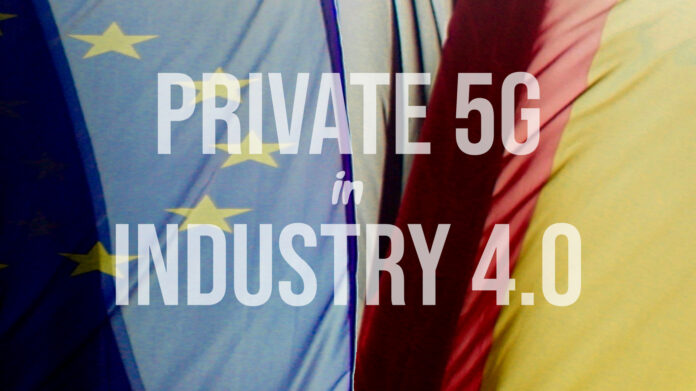Want to know how private 5G is faring at the sharp-end of Industry 4.0? Well, you could do worse than ask a battle-hardened system integrator in its original home. Which is what RCR Wireless did, firing off a bunch of questions to Xantaro Group in Hamburg, in Germany, where the whole Industrie 4.0 concept started, and where the airwaves were first liberated for enterprises to own their own private 5G networks.
The prompt, at the time, was actually because of news that US startup Celona had hired it to take its private 5G product to market – and, also, because a big editorial report about how private 5G scales in Industry 4.0 looms on the horizon. As it goes, and unlike most email exchanges, the answers were sharp and helpful. Which is not what you get, always, with written Q&As, often controlled by corporate PR; but what you get, sometimes, actually, from via straight-talking SIs.
Jürgen Städing, chief strategy officer at Xantaro Group, is candid in his answers, easily discussing the firm’s experiences, strategies, and partners – and comparing the relative products and positions of Celona and Nokia, its other private 5G supplier, in the enterprise space in Germany, and parts of Europe. The market for campus 5G solutions is still in its early stages, but demand is growing strongly,” he says.
He goes country-by-country through the European footprint for private 5G spectrum: Croatia, Germany, Finland, France, the Netherlands, Poland, Sweden, Switzerland, the UK. “The number of countries that have allocated spectrum for private usage is still growing,” he says, as further explanation of his optimism. The business case is tough, often, but the use cases are growing – and the latter will help to refine the former, in time, he suggests.
Nokia’s system is best for big mission-critical deployments; Celona’s best for lighter-touch smaller deployments, he suggests. Between the two, Xantaro Group has the whole enterprise market covered, as far as it serves it. Tellingly, Städing responds to the question of how to make generic out of bespoke systems, in the name of scale: “Bespoke customization and easy scalability are not a contradiction for us. We manage the complexity.”
He adds: “We do not see 5G systems getting any simpler; we just gain more experience and get more used to them, and that includes the customer as well.” Which is justification of the SI discipline, in part, but sounds like a perfectly clear view of how IT technologies for industrial OT systems will never be a box-shifting exercise. There is a good video, here, for the kinds of Industry 4.0 deployments Xantaro has been involved in, and further chat below.
The full conversation is copied below; all the responses are from Städing, pictured below.

…
Has much changed in the private 5G market in the last six months (through 2024) – in terms of culture, collaboration, solutions, verticals, scalability, applications etc?
“We have not seen a major paradigm shift in the last six months. Although the technology is widely accepted by IT managers who are willing and ready to integrate 5G into the network infrastructure, many companies still struggle to develop business cases around this private wireless network solution. The growing number of use cases is inspiring industries to open up for investments into campus 5G solutions. At the same time, we see many small technological advancements, such as broader support for eSIMs. As an integrator, we also welcomed that MDM systems now manage private 5G settings, making everything easier to integrate.”
What is Xantaro’s strategy and approach with private 5G? Which enterprises, which sectors, and which countries are you targeting? Why?
“In this early stage of a developing market, Xantaro’s strategy is to focus on industries which obviously benefit from a 5G solution, but face challenging environments which cannot be covered with traditional wireless technologies, such as Wi-Fi. We address logistics companies with huge areas to cover. Another example; we successfully installed a campus 5G solution on shipyards with hundreds of thousands of tons of dense steel making it hard to cover areas deep within ships. As we focus on technological solutions, we do not offer consulting services for companies to develop a business strategy based on campus 5G. This is not our aim.”
Why Nokia and Celona? What do these vendors offer, differently to others and each other – and when do you offer them to customers, respectively?
“We have a clear focus in everything we do. For our clients, we have no doubt that two 5G vendors offer everything that is needed. Both vendors have a very different approach to 5G, which qualifies each of them for different scenarios. Let’s take Nokia: its background is to supply the big MNOs around the world, which makes the Nokia-solution very flexible and feature-rich, but also very complex. For big MNOs, integrating such a complex 5G solution with their own IT teams is not a challenging task.
“Smaller companies with limited resources couldn’t do that – which is where Celona shines. Celona‘s approach to 5G is inspired by the integration and software aspect. It wants to make 5G as simple as Wi-Fi. Therefore, companies can easily integrate its solution with an existing enterprise IPAM solution, combined with an existing firewall for visibility. A couple of illustrations: for a big shipyard, where integration with the TETRA system for the firefighters is needed, say, we would use Nokia; for a pharmaceutical company where visibility and traceability are paramount, we would recommend the Celona solution.”
How are customers using your private 5G solutions? Are they scaling-up apps and use cases? What is the pattern, and why?
“Most of the 5G installations are still in the pilot phase. The customers already use the technology for some promising and already successful use cases, but they are still working on the many-more opportunities that are still in the drawer. As before, 5G is still a technology, which still has to be fully explored by the corporate world. The trend though is strong and moving forward quickly. The number of use cases for 5G is growing almost day-by-day.”
Is there a challenge to balance bespoke customisation for each customer with easy scalability to drive sales and applications? How do you manage this?
“Bespoke customization and easy scalability are not a contradiction for us; we manage the complexity with automated testing, templating, and automated configuration. We also have our own technical assistance centre, so we are always in the loop if the customer has an issue.”
Are private 5G systems getting simpler? Do they lose anything as a consequence in terms of complexity, and therefore relevance and performance etc?
“We do not see 5G systems getting any simpler; we just gain more experience and get more used to them, and that includes the customer as well.”
Can you name some of these customers, and explain the deployments / applications?
“So we installed a 5G campus network as a ‘connected worker’ initiative across extensive shipyard sites at multiple locations for shipbuilding company Naval Vessels Lürssen (NVL Group), which has shipyard sites on the North Sea and Baltic Sea. The network facilitates connectivity between tasks within the ship’s hull and the control centre across differently structured hulls during all stages of expansion. As steel is an unfavourable material for radio propagation, and as shipbuilders are dealing with unique items, there are no ‘off-the-shelf’ 5G solutions to date. As it was previously not economically viable to set up Wi-Fi coverage in the steel belly of the ship, and cabling was also out of the question, the construction work was highly inefficient in some areas.
“The solution was a 5G network, which ensures reliable networking from the shipyard down to the bilge, the deepest room in the shipbuilding process. This turns the shipbuilder below deck into a ‘connected worker’ that can always be reached wirelessly. After several tests and intensive calculations, the 5G network has proven to be extremely robust, even when used on ships with seven and eight decks, lengths of well over 100 metres and built from several thousand tonnes of steel.”
Are customers going beyond connected workers (people), as a primary use case? Is there much doing in terms of IoT / automation / machines / systems etc?
“Yes, customers are starting to look beyond connected worker use-cases. For example, they are [deploy private 5G] to equip forklifts with IoT devices, so that the position and the battery level are known to a central dispatch system. Also, they are starting to look into environmental monitoring systems because certain stages of production need a certain temperature, humidity, and so on. The biggest holdback for cellular IoT right now is the price of the sensors; they cost easily 15-20 times more than LoRaWAN sensors.”
What is your strategy with regards these two points – about scaling upwards (applications) and outwards (sites)? How is it developing?
“Scaling outward is developing nicely because more and more enterprises see the value of connectivity everywhere. Scaling upwards is more of a challenge as many companies haven’t fully examined the possibilities of digital transformation to further grow their business.”
What are the blockers today? What blockers have been removed in the past six-to-12 months?
“Blockers removed: 5G capabilities in 5G handsets (UE) are now common. Blockers remaining: 5G IoT devices are expensive, and not many are available.”
Is there confidence from enterprises? Why? Because early-adopters are making a difference? Is AI having an impact?
“Yes, there is confidence from the enterprises, because 5G fills a need. I don’t believe that early-adopters make a difference here, because none of them developed the ‘killer’ use case. Right now, AI does not have an impact on 5G solutions for enterprises, but I can see a future where it will. Future iterations of private 5G could use AI to ease the troubleshooting of the system; AI could optimise resource usage of the network and so forth.”

